Pros
Cons
Introduction
Fuji let us know that this year's model has a faster autofocus, better motion detection, an intelligent digital zoom, 3D photographs, and GPS landmark navigation. Some of these features we were able to judge while at CES, others we will have to put through our regular battery of testing to deem them truly worthy. The {{product.model}} will be available in March 2012 in both black and red for an MSRP of $379.95.
Design & Appearance
{{section_header}}{{section.name}}{{/section_header}}
It looks like they sent this new F-Series camera to yoga class, because it's got some really appealing curves this year. Rather than the hard rectangle look, this suave new design seems to be shaped around the lens and the actual shape of the human hand. There is an excellent middle finger grip on the front that fits like a glove. On the back, a bump and some rubber studs hit the thumb perfectly for some excellent one-handed shooting.
The casing is made of a matte rubberized material that is just great. The rubber makes the entire camera very grippable, and there will be no fingerprints, scuffs, or chips on the outside of this Fuji. This spring, black and red versions are available according to a Fujifilm press release, but we have also seen possible blue, champagne, and white variations on their website.
Tour
{{section_header}}{{section.name}}{{/section_header}}




Menu
{{section_header}}{{section.name}}{{/section_header}}
The menus are easy to navigate, especially with the great scroll wheel. There are a whole bunch of options in there from ISO, to aperture, to Face Recognition, white balance, and much more. These options are well organized so you won't get easily lost. All of the functions are located in one menu, the settings, such as date and time, in another.
Ease of Use
{{section_header}}{{section.name}}{{/section_header}}
The button layout is great. With your hand firmly locked on the ergonomic casing, your thumb rests on just about all of the useful buttons. The mode dial is right at the tip of your thumb, though slightly protected by a grip protuberance to prevent accidental mode switching.
The scroll wheel sits where your thumb's inner knuckle rests. The wheel turns smoothly with great indication of how many clicks you are making. You will use the wheel to scroll through menus and the pictures in playback. Just above the wheel is the green playback button and the quick movie button, which is an alternate way to get into movie mode.
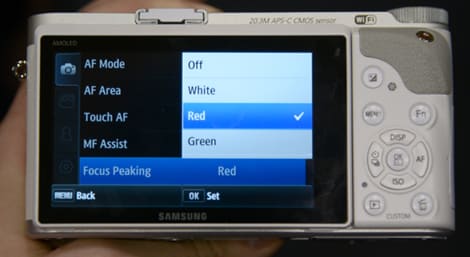

Size & Handling
{{section_header}}{{section.name}}{{/section_header}}
This travel-zoom Fuji model is larger than most point-and-shoots, but much of this is due to the contouring that we found so pleasing to our palm. The {{product.model}} is 4.1 inches wide, 2.4 in height, and 1.4 inches deep.
The {{product.model}} is designed really well for one-handed shooting. The middle finger groove on the front just fits. We felt like we could get a really solid grip on the whole camera without contorting our hands or holding on as hard as we could. In this position, the thumb and pointer finger rest on all of the important buttons in such a way that neither the LCD screen nor the lens are blocked.
The buttons click nicely when pressed. It is easy to distinguish between a half push and a full push on the shutter button, indicating autofocus and taking a picture respectively. The scroll wheel is great. Sometimes scroll wheels can be confusing as to how much you are affecting the product. You can feel a small bump for each adjustment as the wheel turns keeping your connection to the device very clear.
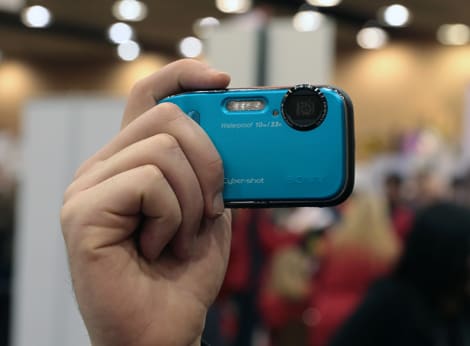
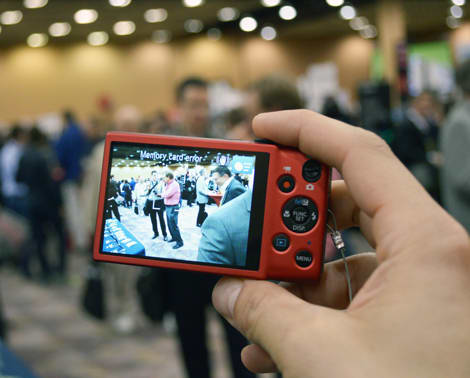
Modes Overview
{{section_header}}{{section.name}}{{/section_header}}
You get a nice range of modes on this travel zoom. In addition to the usual PASM collection, there is an Auto mode, an Advanced mode, an Sp mode, and the EXR mode. The Sp mode is your scene selection mode where you choose which type of setting you are shooting, from natural light, portrait, dog, cat, landscape, sport, night, fireworks, sunset, snow, beach, underwater, party, flower, or text. The EXR is another auto mode that automatically assesses the scene type and optimizes the settings for each particular subject. Advanced mode lets you do some interesting things like take a series of three shots and link them together in a high-res panorama.

Auto Mode
{{section_header}}{{section.name}}{{/section_header}}
There are three auto modes on this Fuji, a regular auto, an Sp auto and the EXR setting, which is an auto mode that employs three different motion blur technologies (image stabilization, high ISO sensitivity, and a new motion detection capability) to assess and optimize photos for particular settings. The EXR has three settings: a high resolution, high dynamic range, and signal to noise setting, where pixels are doubled up to increase sensitivity for low light situations. The Sp auto mode lets you choose your setting manually and then automatically adjusts the exposure options for best results.
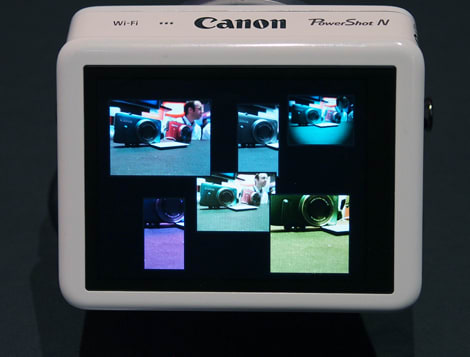
Movie Mode
{{section_header}}{{section.name}}{{/section_header}}
You can record some full HD 1080p video with this travel-zoom from Fujifilm. Knock the resolution of your video down to say 112p, and you can record video at 320 frames per second for some ultra-slow-mo videos, though the resolution will be rather cruddy. The optical zoom also works in video mode, making this camera a pretty solid video recorder all things considered.
Drive/Burst Mode
{{section_header}}{{section.name}}{{/section_header}}
At full resolution (16 megapixels), the {{product.model}} can take almost 8 shots per second, or 11 shots per second producing 8-megapixel photos. You can quickly access the self-timer by pressing down on the scroll wheel, where there are a few different time settings.
Playback Mode
{{section_header}}{{section.name}}{{/section_header}}
The green playback button just above the scroll wheel makes the pictures you have taken appear on the LCD screen. You can see them one at a time, in a slideshow, in a grid of several, or all of them at the same time in a collage.
Picture Quality & Size Options
{{section_header}}{{section.name}}{{/section_header}}
Though the {{product.model}} is just a travel-zoom, Fuji gives you the ability to record your photos in the RAW format for more post production control. There are three aspect ratios available for photos, 4:3, 3:2, and 16:9 each available in three different sizes: S, M, and L. The vertical resolution of these photos starts at 3200 pixels (L) and goes to 1080 (S). You can choose the image compression between normal or fine, accessible by the menu.
Other Modes
{{section_header}}{{section.name}}{{/section_header}}
Yup, you can take 3D photos with this point-and-shoot, but not in the way they advertise it. If you expect to get a 3D image of a guy kicking a soccer ball, like you see in the ads on the website, think again. There is only one lens on the camera, so to create stereoscopy you have to take two consecutive photos shot from different angles and combine them into a single image. Given that a certain amount of time will pass between shots, anything but stationary subjects will have moved to a different position, and the 3D effect will probably be weird at best. But, yes, you can shoot 3D images. Now all you need is a 3D television and a boat load of enthusiasm.
More interesting are the 360º Motion Panoramic and Multiple Exposure modes. You can take a series of photographs in a line, either vertically or horizontally, and this Fuji will link them all together for you in a broad, single photo pan. Using the Multiple Exposure mode, you can superimpose two subjects for some creative and artistic photo magic.
To access these modes, simply move the mode dial to Adv. and select one of these fun, if whacky, features.
Focus
{{section_header}}{{section.name}}{{/section_header}}
Autofocus will work both in the continuous and single shooting modes, even up to 11fps. Fujifilm claims the autofocus speed can be as fast as 0.16 seconds, it was hard to tell when we used it at CES, but we will test it surely in our labs.
The autofocus adjusted quickly and seemed to take accurate photos. We will know more about this feature when we test it thoroughly back in Boston.
Exposure & Metering
{{section_header}}{{section.name}}{{/section_header}}
The {{product.model}} has all three of the standard user control modes: aperture priority, shutter priority, and full manual modes.
When we took a few shots at the Fuji booth at CES, the pictures seemed to be auto-exposed well. They were not blown out, nor were they way too dark. Again, the accuracy of this we will have to run through our tests to say for sure.
The aperture range goes from F3.5 to F11 natively, and up to F16 with the ND filter engaged. When fully zoomed in, the F-stops options are limited to F5.3 to F11.
For exposure compensation, you can go +/- 2 using 1/3-step increments.
ISO
{{section_header}}{{section.name}}{{/section_header}}
The ISO can be set manually or automatically in a range of 100-3200. Using a smaller image size, with the photo in S mode, you can bump the ISO up to a whopping 12800.
White Balance
{{section_header}}{{section.name}}{{/section_header}}
Right in the menu, there is a white balance header, with many different options for the various ambient light settings. The presets are as follows: fine, shade, fluorescent daylight, fluorescent warm, fluorescent cool, incandescent, underwater, and custom where you can choose the exact kelvin you feel is appropriate for the situation.
Image Stabilization
{{section_header}}{{section.name}}{{/section_header}}
The sensor on the {{product.model}} shifts around gyroscopically to stabilize photos. This CMOS shift type stabilization works in tandem with high ISO sensitivity to increase shutter speeds in low light and heavy movement for what Fuji claims is some great photo stabilization.
Zoomed in all the way we did a quick test of the stabilization, taking a photo with it on and off. The difference was noticeable, but to be able to judge accurately, we will have to put it on our rig, shake it around, and have a computer tell us exactly how well it worked.
Picture Effects
{{section_header}}{{section.name}}{{/section_header}}
In Sp mode, you have a choice of many different scene modes that you can choose manually: natural light, natural light with flash, portrait, portrait enhancer, dog, cat, landscape, sport, night, night tripod, fireworks, sunset, snow, beach, underwater, party, flower, and text.
Lens & Sensor
{{section_header}}{{section.name}}{{/section_header}}
This Fuji camera comes with a FUJINON 20x zoom 25-500mm wide angle lens that shoots 16-megapixel images.
The 1/2-inch EXR CMOS sensor is alight for a point-and-shoot. It is not an improvement over last year's model, the F600EXR, and many competing models best it with a 1/2.3 sensor.

LCD
{{section_header}}{{section.name}}{{/section_header}}
Rather than a viewfinder, this FinePix model has a built-in 3-inch TFT LCD screen with a great resolution, using 460,000 dots showing users 100% coverage of their subjects. At CES, the screen looked great, auto dimming with different types of light and diffusing glare well.

Flash
{{section_header}}{{section.name}}{{/section_header}}
The flash can be set to auto, forced, suppressed, slow synchro, and various types of red-eye removal.
The flash itself is has an effective range of 12.1 feet with ISO set to auto.

Jacks, Ports & Plugs
{{section_header}}{{section.name}}{{/section_header}}
There is a full HDMI connector and a mini-plug to USB connection covered by a thick rubberized panel on the {{product.model}}. The panel that covers these ports is firmly in place and will protect the connections very well. Fuji does not say yet what kind of plugs will come with the camera, but we imagine they will include the USB connector.
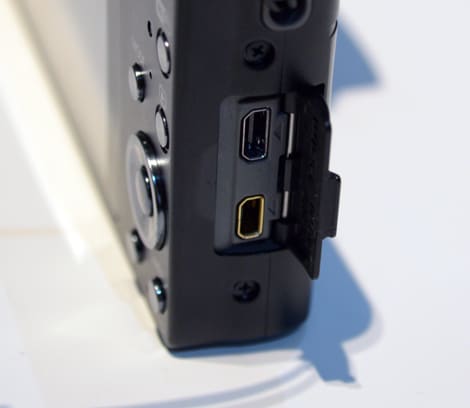
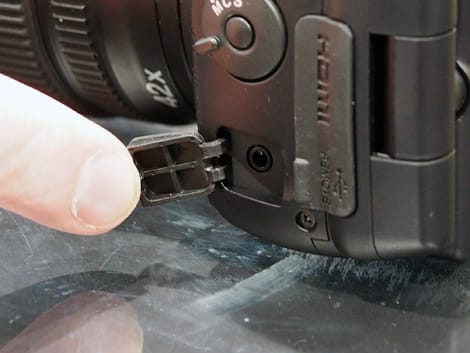
Battery
{{section_header}}{{section.name}}{{/section_header}}
The {{product.model}} is powered by a rechargeable Lithium-ion battery: NP-50A. The charging station is sold separately, but there is an included battery charging adapter. Set to Auto, you can take approximately 300 shots per full charge.

Memory
{{section_header}}{{section.name}}{{/section_header}}
There is 30 MB of internal memory, but that won't last you very long. You will need a memory card if you want to use this camera any kind of seriously. This Fuji takes SD, SDHC, and SDXC cards.

Other Hardware
{{section_header}}{{section.name}}{{/section_header}}
Only this premium model in the F-Series has GPS photo tracking and a landmark navigator. Not only will this travel-zoom record exactly where you took a photo, it will let you know how close you are to a major photo opportunity and give you directions for how to get there.
Conclusion
The {{product.model}} is the best point-and-shoot Fuji will sell in 2012. As an update to the F600 from last year, this model now has a great new body. In the black, matte rubber, this camera looks like a point-and-shoot Batman would buy (but Batman wouldn't have a point-and-shoot - Bruce Wayne maybe - but Batman's got super gadgets). Other than that, pretty much all of the specs and features are the same as the F600EXR from last year.
We liked the ergonomic design, which makes the {{product.model}} excellent for one-handed shooting. But this camera isn't just a looker, the 20x optical zoom, with a possible 30x digital zoom, 16-megapixel CMOS sensor and a host of manual options really fill out this travel-zoom. The loads of manual controls make this model a great pick for the intermediate user.
From testing the F600, we noted significant amount of noise in the pictures. The Fuji pamphlet on the F770 claims to produce 30% less noise, but this is something we will definitely have to test in the labs.
For now, the {{product.model}} looks like a really solid travel-zoom with some advanced features. It will ship in March 2012, in black and red, for an MSRP of $379.95.
{{product.vanity}}
Sample Photos
{{section_header}}{{section.name}}{{/section_header}}
Specs
{{manufacturer_specs_table}}
Meet the tester
Christian Sherden is a valued contributor to the Reviewed.com family of sites.
Checking our work.
Our team is here to help you buy the best stuff and love what you own. Our writers, editors, and experts obsess over the products we cover to make sure you're confident and satisfied. Have a different opinion about something we recommend? Email us and we'll compare notes.
Shoot us an email